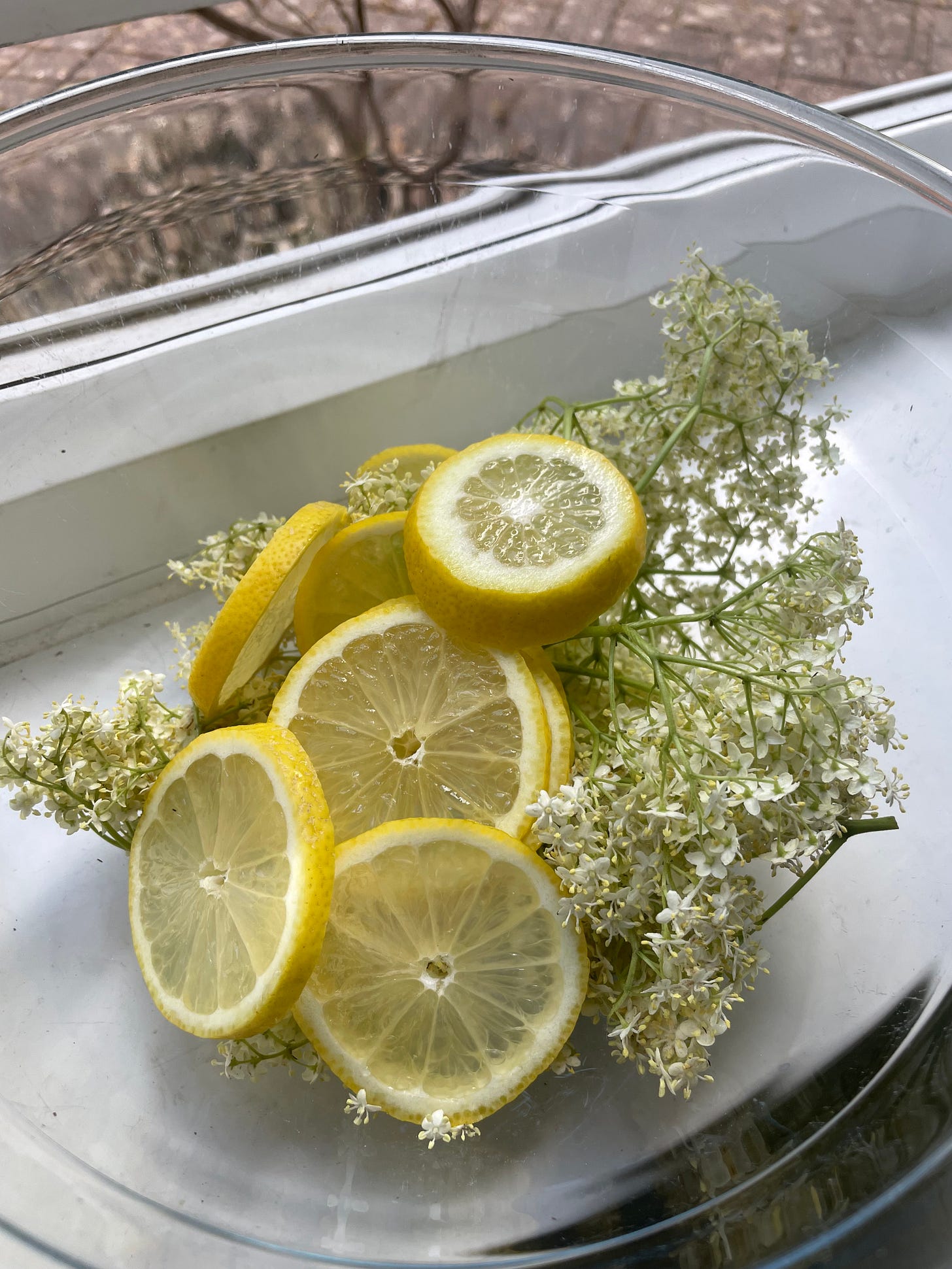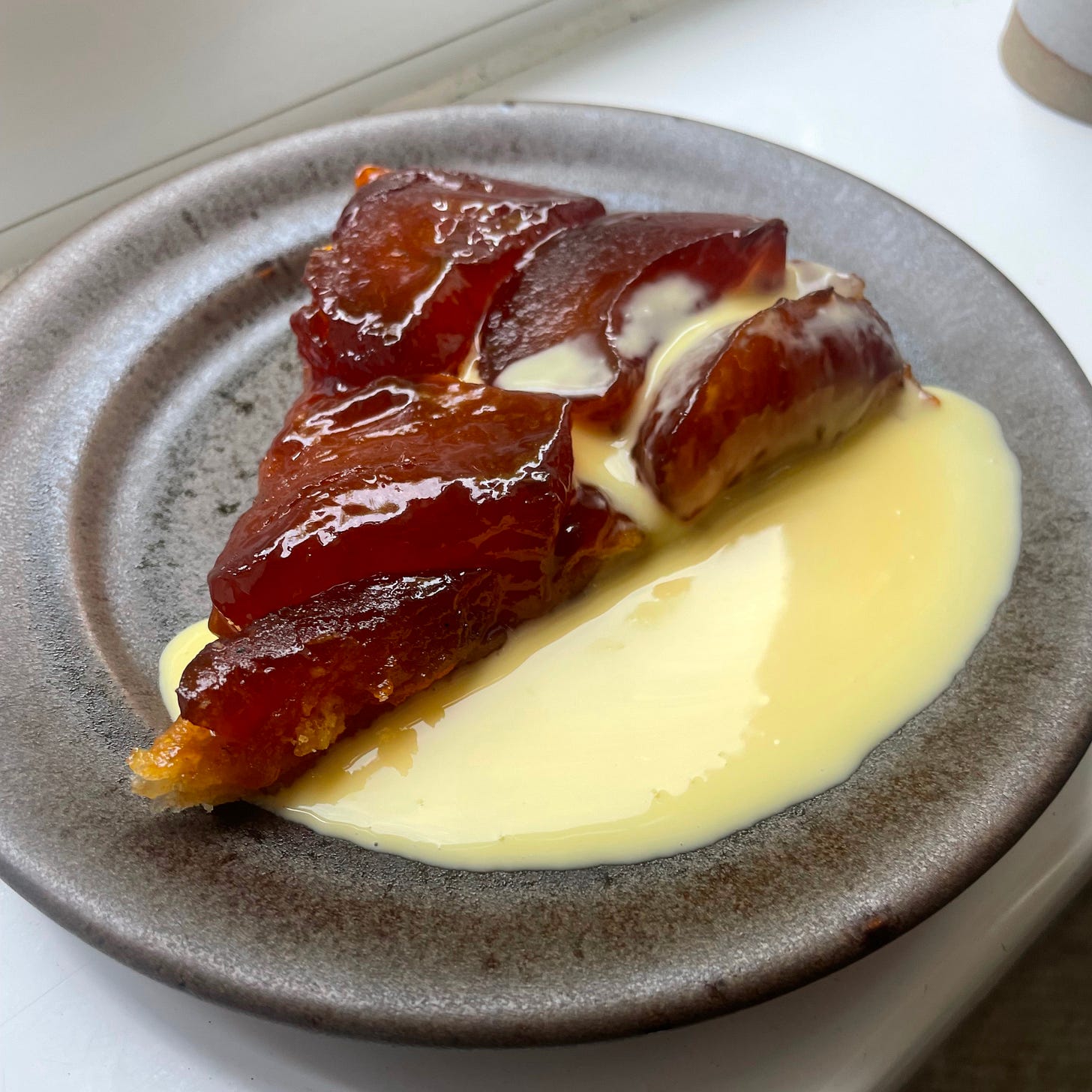Hello!
Just a little note to say I am now offering a paid subscription for my newsletter, which will give you access to two monthly in-depth recipes, alongside the occasional free recipe. This week, I’m sharing a recipe for pickled apple & elderflower tarte tatin, the perfect partner for this crème anglaise. If you fancy upgrading your subscription, you can do so here!
In case you missed it, it’s elderflower season! And it won’t be around for much longer, so I thought I’d better squeeze in a recipe for making the very most of it. This is your chance to preserve as much of the stuff as you can - save a batch for winter and you’ll be able to make this dessert all year round.
As a slightly nervous forager, elderflower is one of a small number of edible flowers I feel I can confidently identify out and about. Its signature smell and clusters of delicate white flowers make it easy to spot, and there are myriad ways of preserving it for cooler months. As it isn’t around for long, I tend to revisit the spots I know with a big bag and process a load of it all at once. I always opt for trees well away from roadsides, and was lucky to get a big batch from the New Forest this year!
I mostly process mine into cordial - despite having grand ideas for making elderflower wines and vinegars, I inevitably don’t have the time to do this and prefer to keep things simple. I make a 20% sugar syrup, and infuse heads of elderflower into this (about 10 heads of elderflower for 1 litre of water) - some people will process the individual flowers, but I tend to just trim the stalks right down to prevent any bitterness and dunk them straight into the syrup. I add a whole lemon sliced up, and let the whole thing sit overnight. The next day, I strain this all through muslin cloth to get rid of any little bugs, pour into tubs and freeze. As the sugar content is relatively low, freezing will help preserve your cordial for longer. You can go sweeter, but I prefer to make the most of the beautiful floral flavour of elderflower.
I find cordial one of the best formats for elderflower - it keeps much longer than the flowers themselves, and can then be incorporated into many different recipes throughout the year. This crème anglaise is no exception and is a lovely addition to any dessert when served hot or cold (I love a chilled custard for warmer days).
But first, what is crème anglaise?
Essentially, crème anglaise is a custard for pouring. This means it isn’t thick or gloopy in the way that the shop-bought stuff tends to be (although I do love this, too). It’s the perfect pairing for a tart (i.e. this week’s tarte tatin!), or any traditional pud, and works beautifully warmed or fridge cold. I’d also encourage you all to try it as a dessert in its own right. Infused with other flavours, it makes for a lovely delicate dessert that can hold its own with no accompaniment.
Unlike so many other things in pastry, a crème anglaise is relatively simple to make. You need just four ingredients: egg yolks, milk, cream, and sugar (plus any infusions you’d like). Much in the same way that we would make a crème pâtissière, we start by whisking together the yolks to break them up, and heating the milk with the vanilla and sugar in a saucepan. When the milk starts to steam, we pour this into the yolks in thirds whilst whisking. This all goes back into the pan and is stirred over a gentle heat until it starts to thicken.
Importantly, we don’t use any starch with a crème anglaise. This is because we want it to be pouring consistency, so we don’t need the starch to gelatinise in the same way as a crème pâtissière. However, with this comes some added risk of the egg overcooking and scrambling because we don’t have that added stabiliser. If you have a thermometer, this can be handy for getting your custard just right, but it isn’t essential.
Just as we do with crème pâtissière, we need to cook the mixture until the egg coagulates, or sets. For egg yolks diluted with milk, as is the case here, this happens at 82°C. As mentioned, you can measure this with a thermometer if you have one. If not, simply use your spatula to test - dip the spatula into the crème anglaise and draw a line through it with a finger. If it runs back into the line, it isn’t ready yet. If it holds and the custard looks nice and glossy, you’re good to go! If you do accidentally take your custard too far, you can always save it by giving it a whizz with a stick blender, although you’ll find it won’t be quite as glossy and luxurious.
Whilst I’ve used elderflower to flavour this custard, you can always remove this, replace with milk,and adjust the sugar content slightly. You can also infuse the milk and cream with whatever takes your fancy. Good places to start are:
fruit zests
fruit leaves, e.g. fig leaves, blackcurrant leaves, or even bay leaves
spices e.g. cardamom, saffron, cinnamon
Elderflower Crème Anglaise
This recipe makes about 500g custard, which serves about 6-8 people (depending on how much you love custard). It can be easily scaled up or down if needed.
I have used a homemade cordial which contains 20% sugar, as opposed to shop-bought which has a much higher sugar percentage. I have offered an option for adjusting the recipe, but should say this is based on some rough maths rather than testing this myself!
170g whole milk
250g double cream
80g elderflower cordial
100g caster sugar (if using shop-bought cordial, reduce this to 40g)
160g egg yolks (about 10 eggs)
Begin by heating the milk, double cream and cordial together until just steaming.
Whisk together the sugar and egg yolks until well combined.
Pour a third of the steaming milk mix over the yolks and whisk to combine.
Pour in another third of the milk mix and whisk again.
Pour the egg-milk mix back into the pan and place over a low-medium heat, stirring constantly.
Keep stirring, getting right into the corners of the pan where it’ll be the hottest. The custard will eventually start to thicken, at which point I like to take it off the heat, stir well and check the temperature. It can tip past 82°C quite quickly, so take the last part slowly.
If serving immediately, eat warm over your chosen dessert. Alternatively, pour into a bowl and place over an ice bath to cool down quickly, before chilling. This can then be served cold, or reheated gently to serve. It’ll last for about 2 days in the fridge.
Annabelle
x





